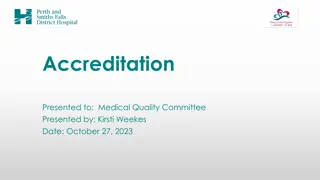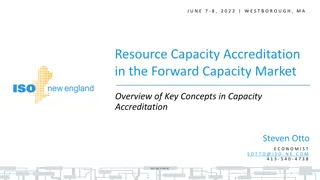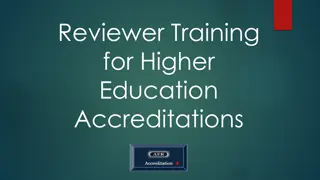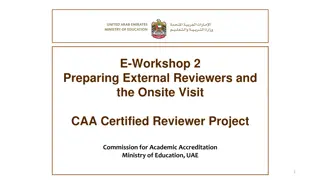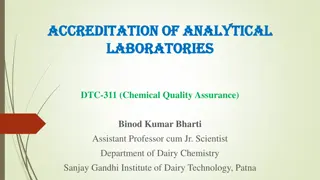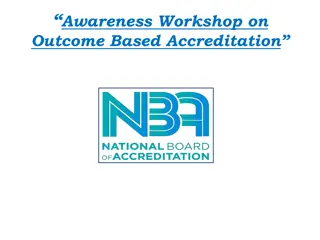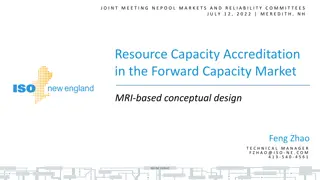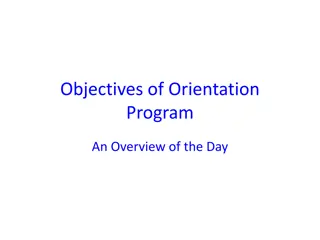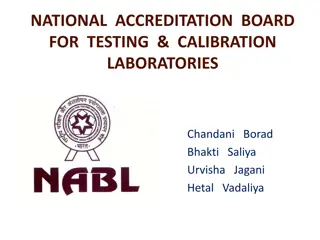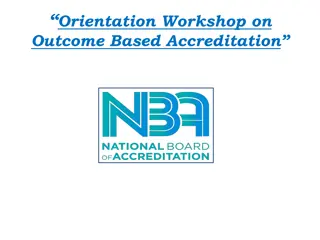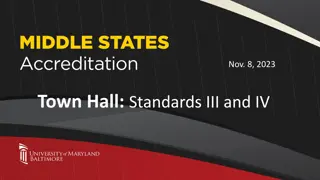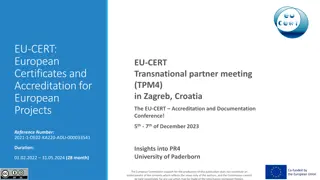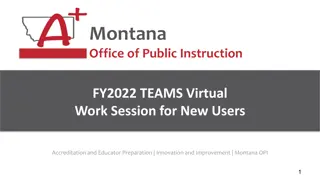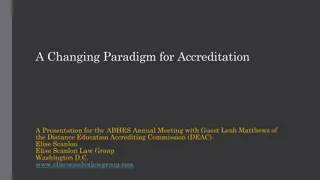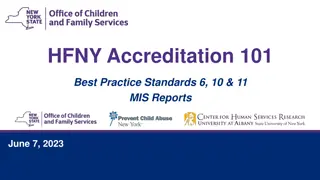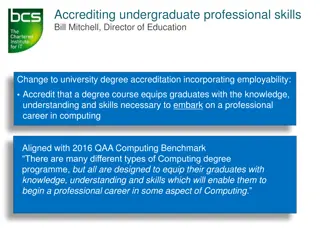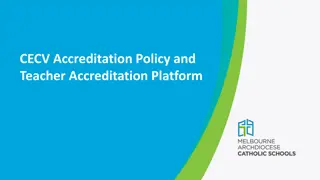Comprehensive Overview of Accreditation Recommendations and Implementation Strategies
This content highlights the importance of Student Learning Outcomes (SLOs) in educational planning, along with recommendations from the ACCJC and strategies to address them. It discusses creating a blueprint for planning, sustainable assessment plans, faculty engagement in assessment dialogue, and the integration of assessment data into program reviews to enhance institutional effectiveness.
Download Presentation

Please find below an Image/Link to download the presentation.
The content on the website is provided AS IS for your information and personal use only. It may not be sold, licensed, or shared on other websites without obtaining consent from the author.If you encounter any issues during the download, it is possible that the publisher has removed the file from their server.
You are allowed to download the files provided on this website for personal or commercial use, subject to the condition that they are used lawfully. All files are the property of their respective owners.
The content on the website is provided AS IS for your information and personal use only. It may not be sold, licensed, or shared on other websites without obtaining consent from the author.
E N D
Presentation Transcript
PVC Accreditation PVC Accreditation Institute Day Presentation September 12, 2014 Dr. Sean Hancock
AGENDA Review Team Recommendations Current Status Accreditation Basics Integrated Planning SLOs Authentic Assessment Program Review Action Plan Reflection
Learning Outcomes Describe the importance of SLOs in planning and decision making. Differentiate the various levels of SLOs and their relationship to one another. Demonstrate ability to formulate an SLO. Define authentic assessment and mastery. Describe the program review process, and the role of SLOs and assessment data.
ACCJC ACCJC Recommendations Recommendations The Commission took action to impose probation and require the College to submit a Follow-up Report by March 15, 2015. The Report will be followed by a visit by Commission representatives.
Recommendation #1 Create a complete blueprint for planning. Regular review of mission statement and current institutional plans that collectively describe how the college will achieve its goals. Mission statement should inform overarching plans. Overarching plans should inform other long-term institutional plans. Plans should include institutional set standards for student achievement, informing annual planning as part of program review. Assessment of SLOs should be integral part of planning process, by embedding SLO dialogue into program review.
Recommendation #2 Develop and implement a sustainable assessment plan ensuring that the College completes a full cycle of SLO assessment that includes discussion of results and action planning at all levels (CLOs, PLOs, ILOs, GE SLOs). College must accelerate its efforts to assess all student learning outcomes for every course, demonstrating: All SLOs included in official course outlines of record are the same SLOs being assessed by faculty, and that assessment of all SLOs is completed on a regular basis.
Recommendation #2 (cont.) Faculty are engaged in ongoing dialogue about methods of assessment, results of assessment and plans for quality improvement based on assessment. The College maintains records of assessment tools and methods used, assessment samples, assessment results, assessment dialogue and action planning based on assessments, and makes these records easily available. Course, program, GE, and institutional SLO assessment data and analysis are integral parts of the program review process and drive efforts to improve course, program, and institutional effectiveness.
Recommendation #3 The College regularly evaluation its processes. Processes used in planning and institutional improvement widely disseminated. Sufficient research support and delegation of responsibility, ensuring regular implementation of all elements of the process, and to inform decision making at all levels of the college.
Recommendation #4 Implement a data-informed process to systematically evaluate the methods of teaching of all courses and programs, including all instructional modalities (DE, CE, F2F), to ensure student learning experience and outcomes are comparable regardless of the method of instruction or delivery.
Recommendation #5 Implement data-informed process to systematically evaluate the instruction methods for all instructional serve agreement courses and programs to ensure the student learning experience and outcomes meet college standards.
Recommendation #6 Establish a policy and process to authenticate the identity of students enrolled in distance education and correspondence education. Student who registers and receives credit for a course is the same student who participates regularly in and completes work for the course.
Recommendation #7 Implement and evaluate an effective part-time faculty evaluation process.
Recommendation #8 Fully implement the agreed-upon process that faculty involvement in SLOs be included as part of the faculty evaluation process and that the college provide evidence that this self-disclosure is effective in producing student learning outcomes.
PVC Status Report PVC Status Report
SLO Progress to Date Subject # of Courses # of Updated COR's # of courses w/SLO's identified # of courses w/matching SLO's Adult Basic Education 27 1 1 6/54 Accounting 5 2 3 0/10 Addiction Studies 9 0 6 16/18 Anthropology 7 0 1 1/14 Art 19 2 6 12/38 Astronomy 3 0 1 4/6 Automotive Technology 16 4 13 20/32 Biology 9 3 5 10/18 Building Construction Technology 17 0 10 16/34 Business 12 1 6 11/24 Chemistry 1 0 0 1/2 Child Development 21 2 7 7/42 Computer Information Systems 17 9 16 22/34 Criminal Justice 17 7 14 19/34 Dance 3 0 0 0/6 Economics 2 0 2 4/4 Education 8 2 0 0/16 EMS 6 2 2 0/12 English 22 0 11 20/44 English As A Second Language 8 0 0 0/16 Fire Science Technology 104 5 5 17/208 Geology 4 0 0 0/8 General Studies 2 0 2 2/4 Geography 4 0 2 4/8 Health Care Ancillaries 2 0 2 0/4 Health Education 7 1 6 10/14 History 6 0 5 10/12 Kinesiology 1 0 0 0/2 Management 7 0 3 4/14 Mathematics 14 0 7 4/28 Music 12 3 3 6/24 Non-Credit Basic Education 50 2 2 5/100 Nursing 21 2 5 10/42 Nursing Science Clinical 3 3 3 0/6 Office Administration 11 0 5 0/22 Physical Education 11 8 10 4/22 Philosophy 5 0 2 4/10 Physics 3 0 0 2/6 Political Science 5 0 1 2/10 Psychology 13 0 1 11/26 Reading 5 4 4 8/10 Sciences 1 0 0 0/2 Sociology 5 0 2 2/10 Spanish 8 1 2 4/16 Speech 5 1 1 4/10 Theatre Arts 5 0 0 0/10 Welding Technology 16 3 11 16/32 Water Technology 4 0 0 0/8 Grand Total 563 68 188 277/1126
SLO Progress to Date Total # Courses # Updated CORs # Course w/ SLOs Identified # Courses w/ Matching SLOs 563 68 188 133
SLOs SLOs Assessment of student learning outcomes and related dialogue should be integral to the planning process, such as by embedding SLO dialogue into program review. To complete a full assessment cycle, the College must accelerate its efforts to assess all student learning outcomes, for every course
SLO Definition Student Learning Outcomes: Clear statements of what a student will learn and be able to demonstrate upon completing a course or program. They describe the assessable and measurable knowledge, skills, abilities or attitudes that students will attain by the end of a learning process. SLOs are action statements for our students. Having an outcome focus at our school keeps us centered on what the students get as opposed to what it is we give.
The Basic Features of SLOs 1. SLOs focus on what learners will do, and not what instructors will cover 2. SLOs use action verbs 3. SLOs aim at higher-level learning and are not content focused 4. SLOs capture the big-picture; the overall, basic purpose of the learning process 5. SLOs capture what students are supposed to do 6. SLOs ask students to apply what they have learned 7. SLOs make reference to criteria used for student assessment 8. SLOs can be assessed
Outcome vs. Objective Outcomes are the BIG picture for a course or program, and they are focused on the student s perspective. There are typically 3-6 SLOs per course and per program. They cover the entire course, and outcomes are the focus of instruction. Mastery of these SLOs is the key to successful completion of a course. To achieve an SLO, an instructor or learning support team member may have to present and assess several objectives. Objectives are the teacher-focused directives that help you lead a student to their outcome.
Why SLOs Student Learning Outcomes are critical because they: 1. Guide instruction ~it shows you what to teach 2. Define assessment ~it shows you what to test 3. Justify the purchase of instructional equipment and classroom supplies ~it shows us what to buy 4. Establish the academic and licensure requirements of faculty ~it shows us who should teach 5. Ensure programmatic requirements (licensing boards, etc.) are met ~it connects to professional organizations 6. Are an accreditation requisite of ACCJC/WASC ~it is the movement of all higher ed to focus more on the student than the teacher or topic
Why SLOs Student Learning Outcomes are critical because they: 1. Guide instruction ~it shows you what to teach 2. Define assessment ~it shows you what to test 3. Justify the purchase of instructional equipment and classroom supplies ~it shows us what to buy 4. Establish the academic and licensure requirements of faculty ~it shows us who should teach 5. Ensure programmatic requirements (licensing boards, etc.) are met ~it connects to professional organizations 6. Are an accreditation requisite of ACCJC/WASC ~it is the movement of all higher ed to focus more on the student than the teacher or topic
Institutional Learning Outcomes SLO #1 Critical and Creative Thinking: Students will identify problems and collect data in order to analyze, interpret, explain and evaluate texts, ideas, works of art and scientific and mathematical problems. SLO #2 Communication: Students will communicate effectively and interactively in written, spoken or signed, and artistic forms. SLO #3 Community and Global Awareness: Students will understand and empathize with diverse cultural, social, religious and linguistic differences within and across societies. SLO #4 Personal and Professional Growth and Development: Students will develop personal, educational and career goals that promote self-reliance; lifelong learning; and physical, mental, and social well-being. SLO #5 Information Competency: Students will identify and collect information effectively from a variety of sources and analyze, evaluate and apply information appropriately. SLO #6 Technological Competency Students will effectively use contemporary technology relevant to their personal and career choices.
Types of Student Learning Outcomes Institutional Learning Outcomes (ILOs) describe the qualities, professional abilities, and outstanding character of stellar graduates, regardless of program. These outcomes are intertwined with PVC mission and values, and can be applied throughout the institution. Program SLOs (PLOs/LSOs) refer to the targeted outcomes of the entire program. Each course within a program should, in some meaningful way, support one or more program SLOs. Course SLOs (CLOs) describe what a student learns and should be able to do at the end of the course. http://www.paloverde.edu/accreditation/slo.aspx
Types of SLOs: Institutional (ILOs) SLO #1 Critical and Creative Thinking: Students will identify problems and collect data in order to analyze, interpret, explain and evaluate texts, ideas, works of art and scientific and mathematical problems. SLO #2 Communication: Students will communicate effectively and interactively in written, spoken or signed, and artistic forms. SLO #3 Community and Global Awareness: Students will understand and empathize with diverse cultural, social, religious and linguistic differences within and across societies.
Types of SLOs: Institutional (ILOs) (cont.) SLO #4 Personal and Professional Growth and Development: Students will develop personal, educational and career goals that promote self- reliance; lifelong learning; and physical, mental, and social well-being. SLO #5 Information Competency: Students will identify and collect information effectively from a variety of sources and analyze, evaluate and apply information appropriately. SLO #6 Technological Competency Students will effectively use contemporary technology relevant to their personal and career choices.
Types of SLOs: Program (PLOs) Outcomes in a program: Every program at PVC has SLOs. These outcomes show what a student will be able to do at the end of their entire program. Each course in the program is linked to these outcomes, showing how all courses direct students to the whole program picture. Samples: AA for Transfer in Sociology SLO SLO #1: See SLO for CSU-GE and IGETC SLO #2: Explain and apply the major theoretical perspectives in sociology. SLO #3: Interpret and communicate the "sociological perspective" and the diverse intersections of social categories, including race, class gender, sexuality, age, religion, and nationality.
Types of SLOs: Program (PLOs) (cont.) Every course leads to a program outcome: Course PLO 1 PLO 2 PLO 3 BA 100 I, D BA 110 D I MKT 100 M ENG 101 D Map used to show all courses within a program, and whether students are introduced to, develop, and master that SLO.
Types of SLOs: Course (CLOs) Outcomes in a course: Every course at PVC has SLOs. These outcomes show what a student will be able to do at the end of the course. Sample: FST 250 SLO #1 Identify hazardous materials and hazardous waste and the various federal, state, and local regulations that apply; respective agencies involved in regulation, enforcement of laws and response to incidents. AST 105 SLO #2 Describe the key orbital and physical properties of Mercury, Venus, Mars, Jupiter, Saturn, Uranus, and Pluto.
Using SLOs How do we use these? In our syllabi In our instruction In our assessments In an assessment/review cycle In our personal reflection of teaching practice
Using SLOs in Our Syllabi Every course taught at PVC requires a syllabus. CLOs are copied from the Course Outline of Record and should be found on every syllabus. They should be incorporated into your daily calendar to help you and the students keep these outcomes as the main focus of all that you do. It is important to distinguish Objectives from SLOs.
Syllabi Content PALO VERDE COLLEGE OFFICE OF INSTRUCTION AND STUDENT SERVICES DEVELOPING A SYLLABUS A clear syllabus gives students a sense of the course structure and should be distributed by the instructor on the first day of class. A typical syllabus provides students with the following information. All full-time Instructors teaching face to face classes, online and correspondence classes should include everything with the * and office location, hour and phone number. Instructors teaching only correspondence courses are to include everything with the*. I understand adjunct instructors you do not an office or office hours, but your telephone number is important to include. - - - - - - - - - - - - - - - - - - - - - - - - Course title and department number * Meeting pattern (days of the week and time) Pre and co-requisites* Instructor s name* Instructor email* Instructor s Office location, hours and phone number (Full time faculty)* Course description from the catalog WORD FOR WORD* Textbook(s) and other required materials* Course objectives from the Approved course outline* Student learning outcomes, check with the Division Chair to ensure you have the latest SLOs* Course bridge information* Unique instructor requirement (i.e. cell phones, testing)* Grading standards* Ground rules (policies) pertaining to attendance, late work, make-up exams and extra credit* Calendar of meeting dates with topics of instructional units to be cover* Examination (including how many and what types)* Assignments (reading and writing)* Cheating policy* Norms of classroom behavior Availability of accommodations for students with disabilities* Library and tutoring availability* Directions for the distribution and returning of course work* Instruction & Student Services Office for face to face and online classes (760) 921-5500 Correspondence Education Department (760)-921-5595*
Using SLOs in Our Instruction As a student, did you ever sit in a class and wonder, Why is she talking about this? When we have an outcome-focused classroom, this will not happen. Everything we do in the classroom should ultimately lead the student toward the outcomes of the course. Therefore, if you think with that end in mind (the outcome), what will you do today to lead them? On the following pages are some teaching guides and ideas, based upon Bloom s Taxonomy.
What is Blooms Taxonomy? In 1956, Benjamin Bloom led a group of educational psychologists to develop a taxonomy, or classification system, for learning. He proposed that learning fits into one of three psychological domains: the Cognitive domain processing information, knowledge and mental skills the Affective domain Attitudes and feelings the Psychomotor domain manipulative, manual or physical skills Within each of these domains, he identified different levels of learning.
Cognitive Domain Learning Outcomes Related to Knowledge Comprehension Application Convert Define Describe Discuss Estimate Explain Generalize Identify Locate Paraphrase Restate Summarize Use Knowledge Cite Label List Enumerate Identify Imitate Match Name Recall Reproduce State Write Analysis Analyze Compare Contrast Correlate Diagram Dissect Differentiate Distinguish Investigate Limit Outline Separate Synthesis Assemble Create Construct Design Develop Formulate Generate Hypothesize Invent Modify Reframe Synthesize Evaluation Access Appraise Conclude Critique Decide Defend Diagnose Evaluate Justify Rank Recommend Support Apply Chart Compute Demonstrate Determine Dramatize Establish Make Prepare Project Solve
Psychomotor Domain Learning Outcomes Related to Skills Recognize Standards Check Detect Discriminate Differentiate Distinguish Notice Perceive Recognize Select Observe Model Correct Apply Coach Hear Identify Observe See Smell Taste Touch Watch Attempt Copy Follow Imitate Mimic Model Reenact Repeat Reproduce Show Adapt Adjust Alter Change Correct Customize Develop Improve Manipulate Modify Revise Build Compose Construct Create Design Originate Produce Demonstrate Exhibit Illustrate Instruct Teach Train
Affective Domain Learning Outcomes Related to Attitudes, Behaviors & Values Responding Valuing Behave Comply Cooperate Discuss Examine Follow Model Present Respond Show Studies Value Receiving Accept Attend Describe Explain Locate Observe Realize Receive Recognize Organizing Adapt Adjust Alter Change Customize Develop Improve Manipulate Modify Practice Revise Characterizing Authenticate Characterize Defend Display Embody Habituate Internalize Produce Represent Validate Verify Accept Adapt Balance Choose Differentiate Defend Influence Prefer Recognize Seek
http://www.odu.edu/educ/roverbau/Bloom/blooms_taxonomy.htm During the 1990's a group of cognitive psychologists, and other educational experts, led by Lorin Anderson (a former student of Bloom's), revised the taxonomy to reflect changes in terminology, structure, and emphasis.
Before we can understand a concept we have to remember it Before we can apply the concept we must understand it Before we analyze it we must be able to apply it Before we can evaluate its impact we must have analyzed it Before we can create we must have remembered, understood, applied, analyzed, and evaluated.
Blooms Cognitive Domain w/ Instruction Ideas Category Verbs Instructional Strategies / Products Remember Recognizing, Recalling Arrange, Count, Define, Describe, Draw, Duplicate, Identify, Label, List, Match, Name, Order, Point, Quote, Read, Recall, Recite, Recognize, Record, Repeat, Reproduce, Select, State, Write Analogies, Audio, Charts, Examples, Illustrations, Lecture, Timelines, Video, Visuals Quiz, Definition, Fact, Worksheet, Test, Label, List, Workbook, Reproduction, Vocabulary Comprehend Interpreting, Exemplifying, Classifying, Inferring, Comparing, Explaining Discussion, Learner Presentations, Questions and Answers, Reports, Summaries, Recitation, Summary Collection, Explanation, Show and tell, Example, Quiz, List, Label, Outline Associate, Classify, Compare, Compute, Contrast, Convert, Describe, Differentiate, Discuss, Distinguish, Explain, Express, Extend, Generalize, Give Examples, Identify, Indicate, Locate, Listing, Matching, Paraphrase, Predict, Recognize, Report, Restate, Review, Rewrite, Select, Sort, Summarize, Tell, Translate Apply Executing, Implementing Demonstrations, Exercises, Microteach, Practice, Projects, Role Play, Simulations, Sketches Photograph, Illustration, Sculpture, Presentation, Interview, Performance, Diary, Journal Add, Apply, Calculate, Change, Choose, Classify, Complete, Compute, Demonstrate, Determine, Develop, Discover, Divide, Dramatize, Employ, Examine, Formulate, Graph, Illustrate, Interpret, Manipulate, Modify, Multiply, Operate, Organize, Perform, Practice, Predict, Prepare, Produce, Relate, Schedule, Shop, Show, Sketch, Solve, Subtract, Translate, Use Analyze Differentiating, Organizing, Attributing Analyze, Appraise, Arrange, Breakdown, Calculate, Combine, Compare, Contrast, Criticize, Design, Detect, Determine, Develop, Diagram, Differentiate, Discriminate, Distinguish, Estimate, Examine, Experiment, Extrapolate, Formulate, Identify, Illustrate, Infer, Inspect, Inventory, Outline, Point Out, Question, Relate, Select, Separate, Subdivide, Test, Utilize Case Studies, Critical Incidents, Discussion, Problems Graph, Spreadsheet, Checklist, Chart, Outline, Survey, Database, Mobile, Abstract, Report Evaluate Checking, Critiquing Appraisals, Case Studies, Critiques, Exercises, Projects, Simulations Debate, Panel, Report, Evaluation, Investigation, Verdict, Conclusion, Persuasive speech Appraise, Argue, Assess, Attack, Choose, Compare, Conclude, Contrast, Criticize, Critique, Defend, Determine, Estimate, Evaluate, Grade, Interpret, Judge, Justify, Measure, Predict, Rank, Rate, Revise, Score, Select, Support, Test, Value, Weigh Create Generating, Planning, Producing Arrange, Assemble, Categorize, Collect, Combine, Compile, Compose, Construct, Create, Debate, Derive, Design, Devise, Explain, Formulate, Generate, Group, Integrate, Manage, Modify, Order, Organize, Plan, Prepare, Prescribe, Produce, Propose, Rearrange, Reconstruct, Relate, Reorganize, Revise, Rewrite, Specify, Summarize, Synthesize, Tell, Transform Case Studies, Constructs, Creative Exercises, Develop Plans, Problems, Projects, Simulations Film, Story, Plan, New game, Newspaper, Media product, Advertisement, Painting, Song
Assessment Assessment
Measuring Success: What is Assessment? Assessment is a means of gathering information (evidence) about student achievement. We tell our students, our communities, and the Department of Education that our students will achieve specific outcomes. We assess our students in order to ensure that they are able to achieve the stated outcomes. How do we know students achieve their outcomes? How do we know our teaching practices are the best they can be? Assessment also creates reflection. As we gather data about student achievement, we can use that data to celebrate our successes, as well as improve our teaching and learning process.
Measuring Success: What is Assessment? (cont.) Assessment is more than a grade. Often the grade of one student does not give us a full picture of whether or not that student has actually learned and achieved the outcomes. Did you ever have a student that hardly ever came to class, yet got an A on the assignments? As the instructor, would you feel the grade was a full reflection of their achievement? Assessment is more than a test. Think of all of the things you do in your course to measure student learning. We certainly wouldn t want to know that a Medical Assisting student had mastered injections by taking a multiple choice exam! We want to look at all appropriate options and methods in which to measure our students success.
Various Assessment Tools Question banks Media Analysis Rubrics Class Debates Tests Scrapbooks Discussions Reflective Writing Essays Skill sheets Research Papers Puzzles Oral Presentations Diagrams & Flowcharts Case Studies Surveys Team Projects Service Learning Models Portfolios
Formative Assessment: Checking for Understanding Assessment can be as easy as asking students at the end of class to: Write down what they learned that day Write a short response summarizing what was discussed during class Write down how today s class meeting links to the previous class meeting Summarize two key points dealt with in class, and to share those two key points with the student sitting next to them Write down what was the clearest and most obscure point of the class today, and address these points during the next class meeting Open their books and quote three passages out of the text that illustrate three points dealt with in the classroom today
Teaching to the Test You have probably heard the phrase teaching to the test. This is often used in academic circles as a taboo, or something to avoid. Yes, teaching THE test is not good form if you show students what you will test, and have them regurgitate that exact info, it doesn t show much learning. However, if you are teaching to the outcomes, shouldn t you be testing to those outcomes as well? Good assessment does actually test to what you teach we lead students to master the important outcomes, and then we assess whether or not they actually have achieved them.
Teaching to the Test (cont.) Think about each assessment you give ,or plan to give, to your students. Does it relate to what you want them to learn? Will you be confident in their ability to achieve the outcomes of the course with the assessments you are giving?
9 Principles of Good Practice 1. The assessment of student learning begins with educational values. 2. Assessment is most effective when it reflects an understanding of learning as multidimensional, integrated, and revealed in performance over time. 3. Assessment works best when the programs it seeks to improve have clear, explicitly stated purposes. 4. Assessment requires attention to outcomes but also and equally to the experiences that lead to those outcomes. 5. Assessment works best when it is ongoing not episodic.



